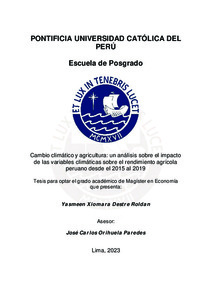| dc.contributor.advisor | Orihuela Paredes, José Carlos | |
| dc.contributor.author | Destre Roldan, Yasmeen Xiomara | |
| dc.date.accessioned | 2023-09-04T18:40:40Z | |
| dc.date.available | 2023-09-04T18:40:40Z | |
| dc.date.created | 2023 | |
| dc.date.issued | 2023-09-04 | |
| dc.identifier.uri | http://hdl.handle.net/20.500.12404/25889 | |
| dc.description.abstract | El cambio climático repercute sobre las diversas actividades económicas, siendo la
agricultura uno de los sectores más vulnerables. Por ello, el presente estudio evalúa el
impacto de las variables climáticas como la temperatura, precipitación y humedad, sobre
el rendimiento agrícola peruano de cultivos de especies vulnerables (café, cacao, palta,
papa y maíz) desde el 2015 al 2019. Para analizar este impacto se emplea un modelo
pooled panel con efectos fijos por distrito. Los datos son provistos por la Encuesta
Nacional Agropecuaria (ENA) y la plataforma pública del Servicio Nacional de
Meteorología e Hidrología del Perú (SENAMHI). Los resultados evidencian que existe
un efecto heterogéneo de las variables climáticas sobre el rendimiento agrícola peruano,
ello de acuerdo con el tipo de cultivo y región natural. En especial, se muestra que las
variables climáticas, temperatura mínima y humedad son relevantes en la mayoría de
los cultivos, de acuerdo con la región analizada. En otro aspecto, los cultivos más
vulnerables al cambio climático son el palto, la papa y el cacao. Respecto a las regiones
naturales, la región Quechua es la más sensible a las variaciones de las variables
climáticas. | es_ES |
| dc.description.abstract | Climate change has various repercussions on economic activities, with agriculture being
one of the most vulnerable sectors. Therefore, this study assesses the impact of climatic
variables such as temperature, precipitation, and humidity on the agricultural yield of
vulnerable species (coffee, cocoa, avocado, potato, and corn) in Peru from 2015 to 2019.
A pooled panel model with fixed effects per district is used to analyze this impact. The
data is sourced from the National Agricultural Survey (ENA, by its initials in Spanish) and
the public platform of the National Meteorology and Hydrology Service of Peru
(SENAMHI, by its initials in Spanish). The results reveal that the impact of climatic
variables on Peruvian agricultural yield varies significantly depending on the crop type
and natural region. Specifically, it is demonstrated that the climatic variables of minimum
temperature and humidity are relevant for the majority of the crops, according to the
analyzed region. Additionally, the study finds that avocado, potatoes, and cocoa are
vulnerable crops to climate change. In regard to natural regions, Quechua is the most
sensitive to variations in climatic variables. | es_ES |
| dc.language.iso | spa | es_ES |
| dc.publisher | Pontificia Universidad Católica del Perú | es_ES |
| dc.rights | info:eu-repo/semantics/closedAccess | es_ES |
| dc.subject | Cambios climáticos--Perú | es_ES |
| dc.subject | Productividad agrícola--Perú | es_ES |
| dc.subject | Cultivos--Efecto de la temperatura--Perú | es_ES |
| dc.title | Cambio climático y agricultura: un análisis sobre el impacto de las variables climáticas sobre el rendimiento agrícola peruano desde el 2015 al 2019 | es_ES |
| dc.type | info:eu-repo/semantics/masterThesis | es_ES |
| thesis.degree.name | Maestro en Economía | es_ES |
| thesis.degree.level | Maestría | es_ES |
| thesis.degree.grantor | Pontificia Universidad Católica del Perú. Escuela de Posgrado. | es_ES |
| thesis.degree.discipline | Economía | es_ES |
| renati.advisor.dni | 06785398 | |
| renati.advisor.orcid | https://orcid.org/0000-0002-2999-5561 | es_ES |
| renati.author.dni | 48026369 | |
| renati.discipline | 311317 | es_ES |
| renati.juror | Guerrero Ochoa, Isabel Graciela | es_ES |
| renati.juror | Orihuela Paredes, José Carlos | es_ES |
| renati.juror | Morales Saravia, Rosa Mabel | es_ES |
| renati.level | https://purl.org/pe-repo/renati/level#maestro | es_ES |
| renati.type | https://purl.org/pe-repo/renati/type#tesis | es_ES |
| dc.publisher.country | PE | es_ES |
| dc.subject.ocde | https://purl.org/pe-repo/ocde/ford#5.02.01 | es_ES |






